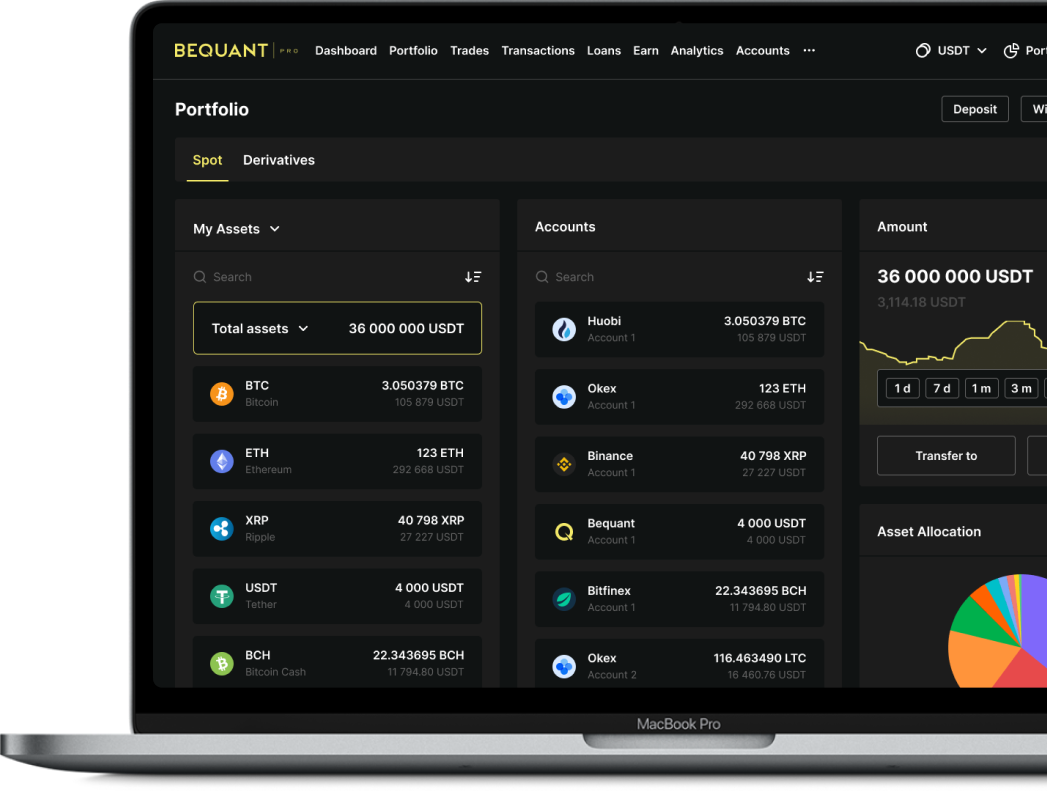Pride comes before a fall

Summary:
The screws will continue to tighten is what the Fed voiced this week, despite continued equity weakness. The weakest links are starting to break as we saw in digital assets, with the collapse of the UST stablecoin and its sister Luna coin, with over $40 bn wiped out in Luna market cap in a few days. This reverberated across the ecosystem to BTC and other stablecoins such as top traded Tether. Despite this, Microstrategy and El Salvador bought the dip, while retail investors bought equities in April, but this week saw strong outflows across assets.
Macro
SWIMMING NAKED
This week, Terra founder Do Kwon’s “cocky” tweets teleported me back to 1980’s Mexico. It was 1982, and the suave, overconfident President Jose Lopez Portillo, in his last year in office and on national TV, promised to defend the peso “like a dog”.
Mexico had been riding high on the back of an oil boom. Oil prices were elevated (topping at US$180 pb) and the government spent generously, with American banks eager to lend, in USD of course. The government even coined the term “managing abundance”.
The abundance proved short-lived. Interest rates in the U.S. started to rise and oil prices collapsed, dollar reserves dwindled. Warren Buffett’s mantra “when the tide is out, we will see who has been swimming naked” proved apt. On February 17, two weeks after that infamous speech, the peso devalued by 80% and capital controls were imposed. These days, things happen faster. It took days for Terra/Luna to unravel, although hardly on the same scale as a nation state.
After that, whenever the former president ventured out in public, people barked at him. It may be that algorithmic coins go down as a failed experiment and fiat-backed ones prevail, within an adequate regulatory framework. But at the moment, concerns have resurfaced around Tether so the story is far from over.
BUYING THE DIP
This year, the S&P is down 19% from its January peak, the Nasdaq -29% and Bitcoin off by 57%, both from their November highs, with balance sheet tapering due to start in June and only two rate hikes in.
Moreover, the Fed is not stepping back with Federal Reserve Bank of San Francisco President Mary Daly backing raising interest rates by a half-percentage point at each of the next two meetings, adding that she’d like to see financial conditions tighten further.
Old habits die hard and retail investors continued to buy the dip in April as they did throughout the pandemic. The ARKK Innovation ETF benefitted from $1bn in inflows year to date despite its underperformance. This week though we saw some strong outflows, as according to Merrill Lynch Investors pulled cash from bonds, stocks, gold and even cash, with $19.3 billion leaving IG, HY and EM debt, the biggest withdrawal since April 2020.
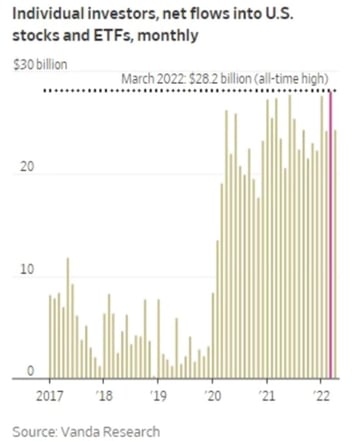
Individual investors bought the dip in April but there were outflows this week
The ARKK Innovation ETF has had inflows YTD, despite being down 60%
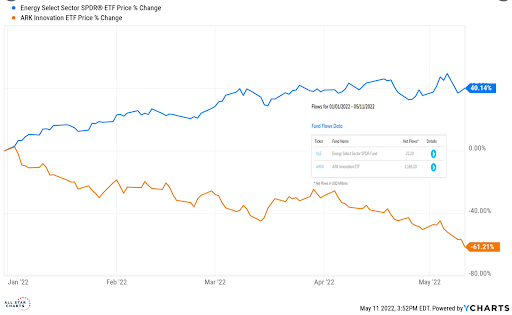
Crypto
IT'S NOT A WONDERFUL LIFE: THE TERRA STABLECOIN DEATH SPIRAL
Crypto stablecoins have a history of depegging but this time it was on another scale and it caused contagion across digital assets, down -20% for the week, with BTC (-16%) faring better than ETH (-23%).
Things started to get dicey over the weekend. Terra, led by Terraform Labs and its co-founder Do Kwon, was riding high with the third-largest stablecoin, UST, with over $18 bn in supply. Some speculate that the whole thing was instigated by a Soros-like player, but there was an inherent weakness in the mechanism, and it was clear that the 19-20% yields on Anchor were subsidized to gain share and unsustainable.
How did the algorithmic stablecoin work?
|
1 Luna = 1 Terra. To mint UST, a user had to burn an equal amount of LUNA. This worked well when demand for UST was rising due to the juicy yields generated by depositing UST on Anchor. Most UST outstanding was deposited on Anchor. |
As UST price rose, it incentivized traders to burn Luna to mint and increase the supply of UST and lower its price. To exit the UST position, a user could redeem UST for LUNA, but UST was
As UST price rose, it incentivized traders to burn Luna to mint and increase the supply of UST and lower its price. To exit the UST position, a user could redeem UST for LUNA, but UST was not backed by any outside collateral, as is the case with USDC or USDT, so there had to be demand for LUNA for it to work.
The death spiral can be an issue as in this instance, where once confidence was lost, everyone ran for the exit and LUNA’s value plummeted. The more UST fell, the more LUNA had to be minted. Unlike in the classic movie about a bank run, It’s a Wonderful Life, there was no happy ending.
The Luna Foundation Guard (LFG) was trying to address vulnerabilities by attempting to raise $10 billion in reserves in the form of BTC. The Terra team was also moving funds into the Curve 4PoolUST to access deeper liquidity, but this plus another $85 mn swap from UST to USDC on the UST-3Curve pool caused concern, setting off an unfortunate chain of events and UST began to depeg on Binance.
LFG sent in the cavalry, using $1.5 bn half of its reserves to lend to market makers to defend the peg, but by then it was too late and deposits on Anchor began to bleed, with on-chain liquidity gone. LUNA hyperinflated by 8000% and its value evaporated as more had to be minted to meet UST redemptions.
Over $40 billion in LUNA market cap was obliterated, causing ripples in other areas perceived to be vulnerable. BTC fell on concerns about LFG selling its reserves and Tether stablecoin depegged to a low of 95 cents, as they do not disclose a detailed breakdown of reserves.
The post-mortem is still being written but retail investors were hurt and authorities are watching. There will be regulatory implications, which will ultimately benefit the system but if Tether, the market leader with $83bn in market cap, loses trust that would have far-reaching implications given their role in providing liquidity to crypto.
Textbook bank run: Most UST outstanding was on Anchor and depositors rushed for the door
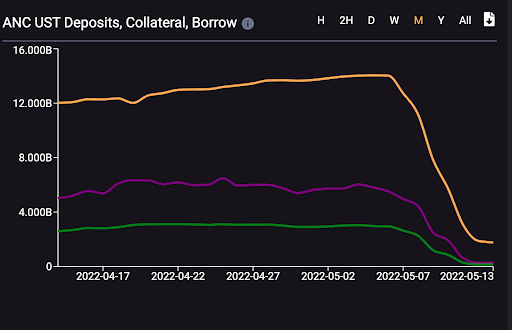
https://terra.smartstake.io/anc
As UST depegged, the price of Luna collapsed due to hyperinflation
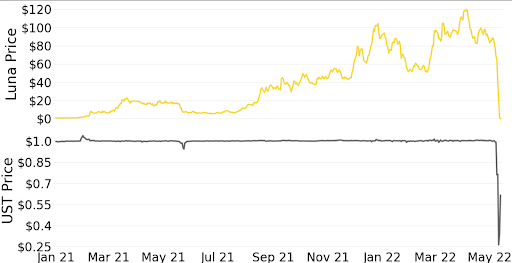
|
Tether depegged to 95 cents midweek, as concerns about its reserves resurfaced and $3bn was redeemed in one day |
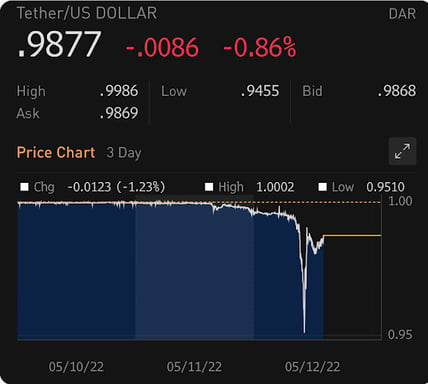
Tether assurance report: lack of transparency around commercial paper makes it a target
UNDERWATER BUT STILL BUYING THE DIP
US retail investors in equities are not the only ones buying the dip. The government of El Salvador, which was the first country to make bitcoin legal tender last year, bought an additional 500 tokens for roughly $15.3 million, paying an average of $30.7k, having previously bought 4010 BTC at $36.7k in January, making for a total of 2.3k BTC worth $70 Mn USD.
El Salvador’s problems are too large for crypto to fix. This week, Moody’s downgraded El Salvador’s sovereign bond from Caa1 to Caa3, maintaining a negative outlook. As interest rates have risen, risk assets have sold off. The country has a +90% debt to GDP level, with no IMF plan insight and a postponed Bitcoin bond, so credit default swaps (CDS) spreads have widened with 10 and 30-year bonds trading at 40 cents on the dollar. There is a principal payment of $800mn coming due in January that needs to be financed. There are $382 Mn in interest payments this year and the nation has $3.4 bn in reserves.
Distressed: Credit default swaps imply a 90% chance of default for El Salvador over the next five years
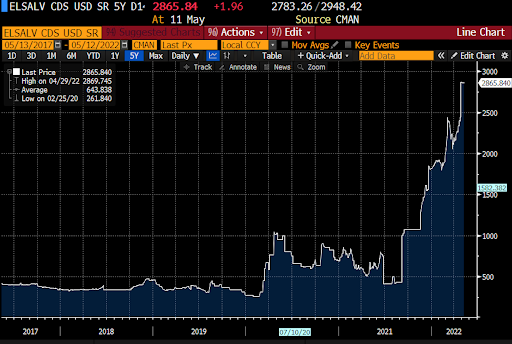
A survey published last month by the National Bureau of Economic Research (NBER) suggests that only 20% of Salvadorans are still using the Chivo e-wallet that the government set up for the population with an initial $30 per user to incentivise adoption for remittance purposes.
Meanwhile, Michael Saylor of Microstrategy was facing FUD of his own. The CEO clarified that the firm has over 115,000 bitcoin that it can pledge as collateral for its BTC-backed loan if prices continue to fall, implying he would not be selling his crypto holdings any time soon.
The company took out a $205 mn loan from Silvergate Bank using $410 mn as collateral to purchase more bitcoin at an average price of $45.7k. The price would have to fall to below $3,562 for Microstrategy to run out of BTC collateral to post. Like El Salvador and many bitcoin HODLers, the company is currently underwater in its investments, with an average purchase price of $30.7k.
COINBASE POSTS A LOSS ON LESS VOLUMES AND RISING COMPETITION
Coinbase (COIN) missed analyst estimates in Q122, as trading volumes fell by 44% from Q421, revenues were $1.17 bn and the bottom line posted a loss of -$430mn vs. a profit of $840 mn in Q421. Monthly transacting users were 9.2 million, compared with 11.4 million in the fourth quarter.
Like many companies, COIN management guided for a weaker Q2 with lower transacting users and volumes (revenues come mainly from transaction fees). The shares have fallen 85% from its highs and 50% this week alone.
With uncertainty on the rise, users were not encouraged by the company’s filing with the SEC detailing that crypto held on behalf of customers could be subject to bankruptcy proceedings, so unsecured creditors.
EXCHANGES ARE STILL PROCURING FUNDING FOR EXPANSION
KuCoin, the fifth largest crypto exchange, raised $150 mn in a pre-series B round at a valuation of $10 bn led by Jump Crypto to grow its offerings including futures and margin trading, lending and passive yield generation, increasing its Web 3.0 presence by building wallets and DeFI and NFT platforms through its investment arms.
Talos, an institutional trading platform based in NY, raised $105 Mn in a Series B round including tradfi banks Citi, Wells Fargo and BNY Mellon, for a $1.25 bn valuation. Existing investors Andreessen Horowitz, PayPal (PYPL), Fidelity and Castle Island Ventures also participated. The funds will go towards more scale and diversification as well as regional expansion in Asia and Europe.
LUNATIC: GALAXY DIGITAL PLUMMETS ON EARNINGS AND POTENTIAL LUNA EXPOSURE
Even before the Terra/Luna death spiral this week, Canada-listed crypto firm Galaxy Digital (GLXY) recorded a net loss of $111.7 million for the quarter ended March 31, 2022, vs. an $858.2 Mn gain a year ago on unrealized losses in trading and investments. The company has $2.7 bn in assets under management, twice last year’s level but down 5% quarter over quarter.
CEO and high-profile crypto figure, Mike Novogratz, a self-proclaimed Lunatic, expects continued volatility and a BTC price of around $30k, with ETH at $2k. Shares of Galaxy Digital were down 40% this week on a soggy market and weak earnings plus concerns around the company’s potential exposure to the Terra ecosystem given Novogratz’s support.
Regulation
TERRA: CATCHING THE GOVERNMENT'S EYE
As Terra stablecoin was de-pegging and Luna collapsing, U.S. Treasury Secretary Janet Yellen focused on the risks attached to algorithmic stablecoins during testimony before a U.S. Senate panel this week. Yellen told senators that UST experienced a run and that the risks have already been described in the President’s Working Group on Financial Markets. If anything, the event may finally get reactive-prone regulators to take action.
|
"I think that simply illustrates that this is a rapidly growing product and that there are risks to financial stability, and we need a framework that's appropriate," Yellen on UST |
DeFi / NFTs / Metaverse
JUNK RATING: CREDIT-SCORING DEFI
Tradfi credit scoring agencies have a far from a stellar record in evaluating corporate and sovereign debt, with some accusing the industry of conflicts of interest. However, in what appears to be a first, major firm S&P has scored DeFi platform Compound’s Treasury product, giving it mixed reviews and a B- rating, with a stable outlook.
A B rating falls in the non-investment grade bucket, in other words, “junk”. Cons include a low capital base, regulatory and operational risk and complexity. The treasury offering is small as Compound’s +$5bn TVL is in lending.
INSTAGRAM DABBLES IN NFTS
Soon after Coinbase opened its NFT platform to all users, to mixed reviews, Insta unveiled its “Digital Collectibles” product and said it wants to turn NFTs into a revenue stream for creators using the app. Some of them will be able to display their digital art on Instagram but not sell or trade them at this point.
It seems the platform, with billions of users, has not defined a strategy yet and is treading carefully given other failed launches such as gamer Ubisoft, which faced pushback from its fans for introducing NFTs. Ultimately, the idea is to retain and attract creators by offering ways to monetize their work.
Until next week!
This document contains information that is confidential and proprietary to Bequant Holding Limited and its affiliates and subsidiaries (the “BEQUANT Group”) and is provided in confidence to the named recipients. The information provided does not constitute investment advice, financial advice, trading advice nor any other sort of advice. None of the information on this document constitutes or should be relied on as, a suggestion, offer, or other solicitation to engage in or refrain from engaging in, any purchase, sale, or any other any investment-related activity with respect to any transaction. Cryptocurrency investments are volatile and high risk in nature. Trading cryptocurrencies carries a high level of risk, and may not be suitable for all investors. No part of it may be used, circulated, quoted, or reproduced for distribution beyond the intended recipients and the agencies they represent. If you are not the intended recipient of this document, you are hereby notified that the use, circulation, quoting, or reproducing of this document is strictly prohibited and may be unlawful. This document is being made available for information purposes and shall not form the basis of any contract with the BEQUANT Group. Any transaction is subject to a contract and a contract will not exist until formal documentation has been signed and considered passed. Whilst the BEQUANT Group has taken all reasonable care to ensure that all statements of fact or opinions contained herein are true and accurate in all material respects, the BEQUANT Group
